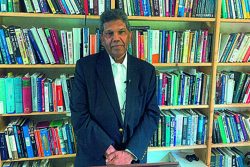As passionate as we are, it is still impossible for West Indians to fully comprehend the intensity with which the people of the second most populous nation on earth are gripped by cricket, a game bequeathed to their widely diverse people by their one-time colonial overlords.
The fervor in India is most conspicuous when it relates to the nation’s greatest player, Sachin Tendulkar. It was never more so than in the ourpourings that followed his decision last week to retire after his 200th Test, the second against the West Indies in December.
Of the hundreds of thousands of words prompted by his simple letter informing the Board of Control of Cricket in India (BCCI) of his intention, 10 in a headline in an Australian newspaper were most appropriate: ‘Nation mourns as its Little Master prepares for final innings’.
 Tendulkar has played alongside other outstanding batsmen in his time – most notably Rahul Dravid, V.V.S.Laxman (both now retired) and Virender Sehwag (soon to be). Younger batsmen, some not yet born or mere babes when Tendulkar played his first Test in November 1989, are now lining up to fill the gaps.
Tendulkar has played alongside other outstanding batsmen in his time – most notably Rahul Dravid, V.V.S.Laxman (both now retired) and Virender Sehwag (soon to be). Younger batsmen, some not yet born or mere babes when Tendulkar played his first Test in November 1989, are now lining up to fill the gaps.
The West Indies ‘A’ team encountered one last week, Cheteshwar Pujara, who reeled off his third first-class triple hundred against them; he already has an average of 65 in 13 Tests with a double and three single hundreds.
But no one expects Tendulkar’s likes will be seen again. And, in an age when the longest and purest form of the game is fading from the itineraries, it is certain no one will survive for 200 Tests, unless science devises some magic formula to preserve youth for centenarians.
It was not as if last week’s announcement was unexpected. Tendulkar is now 40; the passing years have inevitably taken toll on eyesight and reflexes. The last of his 51 Test hundreds was in January 2011, against South Africa in Cape Town; he gave up the one-day game in March 2012 after scoring his 49th ODI, and 100th , international hundred.
Yet, for 24 years since his debut Test, aged 16, he has been the central figure of India’s eventual rise to the top. And, rational Indian leaders contend, his influence extends beyond cricket. On the field, they point out, his standards of excellence were an example that epitomized the nation’s economic boom.
His statistics are as staggering as his longevity and as his unassuming modesty in an environment that regards him as a demi-god.
In an era of lucrative returns for players, especially in his homeland, he has inevitably become a very wealthy man. But there has never been a controversy to tarnish his image, on or off the field, never irritation at the constant fawning of his millions of devotees, from high-profile Bollywood stars and moguls of media and business to lowly taxi drivers and fruit sellers.
He has accepted his status that confines him to driving through the streets of Mumbai in his favourite sports cars in the dead of night, to avoid being mobbed.
Had he been West Indian, he would have been free, as the other sublime batsman of his time, Brian Lara, is to jump in Carnival and Kadooment or Chris Gayle to mingle with the fans in the stands without adoring harassment.
India’s is a different culture. It explains why his 1.2 million countrymen mourn in the distressing reality that, after December, they won’t again rejoice as Tendulkar churns out more runs for their nation.
+++++++++++++++++++++++++++++++++++
While the men were losing their first four-day ‘A’ team ‘Test’ in eight matches in the Indian town of Hubli and the under-19 boys’ problems against spin were being starkly exposed by their Bangladesh counterparts in Guyana, the West Indies women continued their impressive improvement at Sabina Park last week.
Beaten by one run as much by themselves as New Zealand in the first of the series of three ODIs, their complete domination of the other two was reflected in victories by 89 and 95 runs.
The teams have moved south for a triangular contest starting at Kensington Oval tomorrow. England, the third team, will be a stern challenge, even if, for various reasons, they are without a couple of their best players. At least the West Indies start with the confidence of last week’s triumph and a 2-1 series win over England in St. Kitts four years ago behind them.
Merisa Aguilleira, the wicket-keeper and captain since 2009 in 56 of her 64 ODIs, described the Sabina feat as “a real team effort”. Indeed it was.
To the fore was an all-rounder as outstanding in the women’s game as any male has been for the West Indies – well, Sir Garry Sobers probably excepted but not by much.
Stephanie Taylor is a 22-year-old Jamaican, a right-hand batter (that’s the preferred, unambiguous term used for ‘batswoman’) of conventional style and a canny off-spinner. In 67 ODIs, her 2,626 runs come at an average of 45.27 (ahead of all of her male contemporaries); these are supplemented by 91 wickets at 16.30 each.
Such statistics have gained her a steady ICC batting rating among the top four and as the No.1 all-rounder.
In Thursday’s decisive match, her unbeaten 135 from 148 balls underpinned a total of 238 for six; she followed up with four for 35 off eight overs as the New Zealanders were dismissed for 143 from 43 overs.
For Aguilleira it was “an amazing feeling” to defeat opponents from a country where, as in Australia and England, the women’s game has been properly structured and taken seriously since the 1930s; they are the only ones to have been World Cup champions in the nine staged since 1973.
In the West Indies, as elsewhere, it received limited official attention until recently. In the inaugural World Cup in England, for instance, Jamaica and Trinidad and Tobago played on their own. None of the other territories had enough players for a local competition.
All that has changed, more especially over the past dozen years or so.
The other major cricket-playing nations, in addition to Ireland and the Netherlands, have joined the international circuit. Along with the World Cup and the World Twenty20, there are other regular multi- and bi-lateral series. As well as hosting, the West Indies have been everywhere on cricket’s map over the past ten years.
Sherwin Campbell, the former Test opener, was appointed women’s team coach by the West Indies Cricket Board (WICB) three years ago. The leading players have been placed on professional contracts. The effect has been obvious.
The West Indies were runners-up to Australia in the most recent World Cup in February (having beaten them in the earlier round). They were semi-finalists in the World Twenty20 in the Caribbean three years ago.
If, as always, there has been no promotional campaign for the imminent triangular at Kensington Oval, the WICB is underwriting live television coverage. It is exposure that the women’s game deserves. It should be well worth watching.










